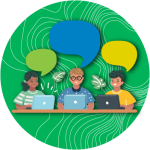
One thing you can say about the year 2020 is that it is not subtle at all. So one day TP is no big deal, but the next, it’s completely AWOL from every major and minor retail outlet in the country! Are you feeling that way about the school year as well? Well, you are not alone. Clearly those parenting books you read didn’t prepare you to turn your apartment into a classroom or figure out why the Zoom meeting your child is having RIGHT NOW has no volume or how to “upload” your kid’s assignments to a “dropbox” in the “cloud” before midnight!
While some of these are major obstacles to overcome, a side benefit to your children learning from home is that you develop a much better understanding of how your child does and doesn’t learn.
If you are wondering why your child is struggling, it can be overwhelming when you try to figure out the problem. The first thing to do is connect with your child’s teacher of course, but if you want to learn more yourself, check out this great tool from Understood called Take N.O.T.E.
What is N.O.T.E.?
This program uses the memory device “Take N.O.T.E.” to help families spot signs of possible learning disabilities and ADHD in their children. The process begins with Notice, then Observe, Talk and finally, Engage!
The N.O.T.E. initiative includes free, digital-first resources in English and Spanish for families to use when they notice their child struggling with behavior changes or are concerned about a learning process that isn’t working or has stalled.
Understood worked with the American Academy of Pediatrics on the development of this project in response to recent findings:
“A new Understood/YouGov survey of more than 2,000 parents of 5- to 17-year-olds found that 69% have become more aware of the challenges their child faces in school than before the pandemic, and more than a third (37%) report noticing changes in their child’s behavior. Yet among the parents who noticed changes in their child’s behavior, fewer than 1 in 3 (28%) sought guidance or support from a health care provider.”
Along the way, you are given suggestions, relevant articles and graphic organizers to help you analyze what is happening with your child as they learn and how you can help. Just another way to tackle the roller coaster of a ride that 2020 has been!
Visit Learn at Home for even more great resources, including:
- Free online tutoring
- Online tools available 24x7x365
- Recommended items from our collection that you can pick up curbside


